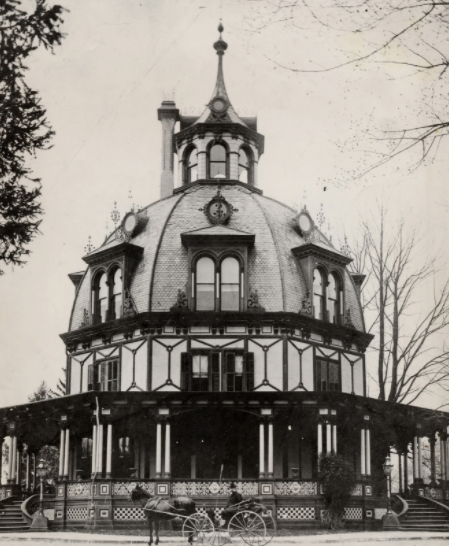The Armour-Stiner House: The only fully-domed octagonal house in the world
 |
The Octagon House is shown in an early 1870s photo complete with horse-drawn carriage in the drive. Joseph Stiner added the iconic dome and wraparound veranda to the house in 1872 after purchasing the house and estate from financier Philip J. Armour, who built a simpler version of the house in 1859-60. (Irvington Public Library, Local History Collection)
The Armour-Stiner House, or more commonly the Octagon House, stands at the southwest intersection of West Clinton Avenue and the Old Croton Aqueduct near the Hudson River in the Village of Irvington.
It is the only known fully domed octagonal residence and the only house in the world which replicates Donato Bramante’s 1502 Tempietto in Rome, according to the website for the National Historic Landmark.
In 19th century America, octagonal houses were popularized by the book, “The Octagon House, A Home for All,” by Orson Squire Fowler, an amateur architect. Fowler proposed that octagonal houses were most efficient to build, gave access to the most sunlight and were cheaper to heat and cool than traditional houses.
They also featured a type of room rarely seen in any other houses -- triangular rooms of which the Octagon House includes many.
The house, which still stands at 45 West Clinton Avenue, was built in 1859–1860 by wealthy financier Paul J. Armour and purchased in 1872 by Joseph Stiner, a prominent New York tea merchant. Stiner’s alterations included the addition of the iconic dome and veranda.
The 8,400-square-foot house features 20 rooms with a 2,500-square-foot wraparound veranda porch. Ceiling heights range from 11 to 14 feet and the house is situated on a 4-acre estate with a formal garden, a Lord & Burnham greenhouse and a carriage house/studio.
Subsequent owners of the house included in the 1930s Aleko E. Lilius, a Finnish writer and explorer. One of the most celebrated occupants was author, poet and historian Carl Carmer. Carmer lived in the house from 1940 until his death in 1976.
Carmer’s legacy includes the tale of a resident ghost and plays a role in a number of his published stories.
According to Carmer in his 1956 book, "The Screaming Ghost," a ghost known as the white lady haunts the VIctorian Octagon House, sticking mostly to the third floor. She reportedly was a visitor to the house one summer, fell in love with a neighbor’s son and eloped with him when their parents disapproved of their union. According to the story, they died in a maritime accident on their way to New York, and her spirit returned to haunt the house.
 |
| This aerial photo taken from approximately the Old Croton Aqueduct State Park trail looking past the Armour-Stiner House to the Hudson River gives an idea of the expansive views of the 19th century mansion. (Photo courtesy armourstiner.com) |
Shortly after Carmer’s death, the house was acquired by the National Trust for Historic Preservation to prevent its demolition. It was designated a National Historic Landmark in the same year, 1976.
The National Trust could not afford to fund restoration of the house and so sold it in 1978 to preservation architect Joseph Pell Lombardi, the current owner, an Irvington High School alumnus.
Again according to armourstiner.com, under the direction of his son, Michael Hall Lombardi, the Lombardi family has researched and restored the house and grounds to their 1872 appearance.
The interior of the house, its decorations and its 1870s furnishings are considered to be the best display in the country of the American neo-Roman style, popular for a brief period in the third quarter of the 19th century.
The house also features the only domestic Egyptian Revival Music Room in existence that includes its original 19th century furnishings and decoration.
 |
| Pictured are the restored front stairway and wraparound veranda of the Octagon House, which has opened for public tours since its lengthy restoration. (Photo courtesy armourstiner.com) |










Comments
Post a Comment
If you would like to weigh-in, feel free ...